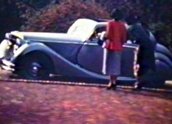

The New Car (1953)
Synopsis
In the early 1900s, a well-to-do family eagerly await the delivery of their new Renault. When it arrives at their property, they pack a picnic lunch and go for an afternoon drive through the countryside. At the end of their outing, the car breaks down and they are forced to push it the rest of the way home.
Cutting to the present day (1953), a man dozing in a deckchair on a lawn wakes up from a dream. It appears that what we have just seen was all in his head. A horn sounds the arrival of the family’s new car – a shiny new Jaguar – and the two young women who have been sitting with him on the lawn run over to have a look at it. The family and friends then take it for a drive and pass a vintage car parade on their travels which features a car very much like the old Renault in the man’s dream.
Curator’s notes
The New Car was made by the amateur filmmaking group the Adelaide Filmo Club. An ambitious amateur production, most of which is set in the early 1900s, the film was shot on location at the historic homestead Cummins in Morphettville, South Australia. As with most amateur or short film productions, many of the objects that appear in the film were provided by friends and through local networks with people in the Adelaide community. The period costumes were provided by Filmo Club patron JT Mortlock and were clothes that members of his family had worn in 1900. The car that features in the opening section of the film was provided by a member of a vintage car club. The horses in the film actually belonged to the local Commissioner of Police, with whom John Mack was acquainted.
In 1988 a copy of the film was made, by which time the original print had shrunk and the step printer had trouble producing a flawless copy. The resulting film was transferred to video by John Mack’s son Peter and it is from this copy that the images come. Despite the numerous transfers and obvious colour fading, the detail of the costumes and the elaborate settings still shine through.
The scenario switching between dream and reality resonates with another amateur production by Mack, Magical Powers (1936). Using an extended dream sequence as the narrative’s primary temporal space provides the opportunity to use a beautiful location, period costumes and vintage cars in a creative way. At the end of the film, the punch line is that all that has come before was merely a dream of the main character. Waking up in the present, the closing moments of the film echo the beginning, but in a 1950s setting. The new car is now a new Jaguar and the women wear dresses far less elaborate than their 1900s attire.
While the original print of the film no longer survives, the State Library of South Australia holds location photographs of the cast and crew of The New Car in its collection along with periodicals of the Adelaide Filmo Club.
The film was shown at the local film club as well as having a screening with accompanying music.
- Overview
- Curator’s notes
- Video 2 clips
- Find a copy
- Make a comment
- Map
- Add your review



